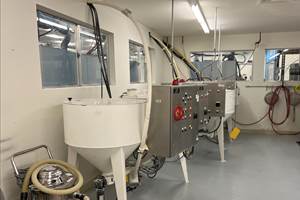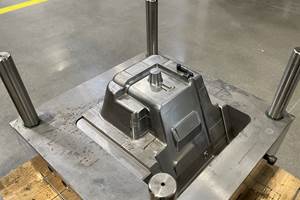AddUp Adds Constellium’s Aheadd CP1 Aluminum Alloy to Material Portfolio
The Aheadd CP1 aluminum alloy was developed by Constellium for the needs of additive manufacturing by laser powder bed fusion specifically for high-performance and lightweight applications.
AddUp has expanded its material portfolio by adding Constellium’s Aheadd CP1 aluminum alloy to its FormUp 350 machines, offering a high-performance alternative to traditional aluminum alloys for additive manufacturing (AM).
Constellium’s Aheadd CP1 alloy can now be used on AddUp FormUp 350 machines. This aluminum alloy is specially developed for the needs of AM and is said to provide an interesting alternative to traditional grades such as AS7 or AS10, with higher productivity and better performance for heat dissipation applications.
AddUp qualified the new aluminum alloy Aheadd CP1 for FormUp 350 machines. This alloy was developed by Constellium and was designed for the needs of AM by laser powder bed fusion (LPBF) specifically for high-performance and lightweight applications.
The current AM market is dominated by AS7 and AS10 grades (alloys of aluminum, silicon and magnesium, originally created for the foundry industry). Constellium offers an aluminum-iron-zirconium alloy with higher solderability which makes it possible to increase laser power and scan speed, and therefore to improve productivity. The gains can range depending on the type of part to be printed, and more could be achieved in the next years.
Above all, with Constellium alloy, post-build operations are simplified. “To obtain the best mechanical properties using AS7 and AS10 grades, several long and expensive post-build treatments must be carried out, such as hot isostatic pressing and, solution and aging, etc.,” says Frédéric Sar, Materials Officer at AddUp. “With Aheadd CP1, very similar material properties can be achieved with a simple heat treatment at 400°C.”
Saving time and money on these post-printing operations, which represent up to 40 to 50% of the cost of LPBF parts, can make a difference in the profitability of an application.
In detail, the mechanical properties of parts made by AddUp from Aheadd CP1 (particle size 20-63 micron) are close to those of AS7 in terms of hardness, at least equivalent in fatigue resistance and higher in ductility. These parts are also compatible with anodizing treatments to improve corrosion resistance.
Higher thermal conductivity of Aheadd CP1 compared to traditional aluminum alloys makes Constellium’s alloy a better candidate for heat exchanger applications. This alloy is stable up to 250°C without degrading its microstructure. Therefore, the parts made out of this material can be used at higher temperatures compared to AS7, which paves the way for lightweight applications for the aerospace industry.
All these characteristics make Aheadd CP1 a potential alternative to AS7 and AS10 alloys for 3D printing. This material was recently approved in the field of motorsports. Combining this material with performance of the AddUp FormUp 350 machine, increases the productivity without compromising the part quality. This material could quickly gain significant interest in many other industrial sectors, including aeronautics and aerospace.
- Read about AddUp’s participation in a $1.5 million USAF Research on IN-718 additive manufacturing. AddUp is partnering with Zeda to provide critical project support to provide the USAF with a set of manufacturing guidelines to maximize the capabilities of LPBF to meet fleet readiness and sustainment goals.
- Read about another Addup collaboration with Zeda — this time for aerospace and medical additive manufacturing. The first of eight AddUp FormUp 350 powder bed fusion machines deployed has been installed at Zeda to support its growth in the aerospace and medical sectors.
Related Content
A Tour of The Stratasys Direct Manufacturing Facility
The company's Belton manufacturing site in Texas is growing to support its various 3D printing applications for mass production in industries such as automotive and aerospace.
Read MoreAluminum Gets Its Own Additive Manufacturing Process
Alloy Enterprises’ selective diffusion bonding process is specifically designed for high throughput production of aluminum parts, enabling additive manufacturing to compete with casting.
Read MoreDaimler, OMIC Evaluate Wire-Fed DED for Moldmaking
3D printing a core and cavity on machine from Gefertec, followed by machining, allowed for a complete mold tool to be produced in three days.
Read MoreHow AM Enables Cobot Automation for Thyssenkrupp Bilstein (Includes Video)
The shock absorber maker has responded to its staffing shortages through extensive use of collaborative robots. In-house 3D printing makes this possible by providing the related hardware needed to complete the cobot-automated cells.
Read MoreRead Next
To Improve Performance of Compression Molded Composites, Add 3D Printed Preforms
9T Labs' Additive Fusion Technology enables the manufacture of composite structures with as much or as little reinforcement as is necessary, using 3D printed continuous fiber preforms to add strength just where needed.
Read MoreLooking to Secure the Supply Chain for Castings? Don't Overlook 3D Printed Sand Cores and Molds
Concerns about casting lead times and costs have many OEMs looking to 3D print parts directly in metal. But don’t overlook the advantages of 3D printed sand cores and molds applied for conventional metal casting, says Humtown leader.
Read MoreGE Additive Rebrands as Colibrium Additive
As part of the brand name transition, both the Concept Laser and Arcam EBM legacy brands will be retired.
Read More












.png;maxWidth=300;quality=90)











